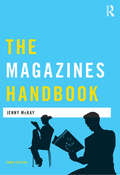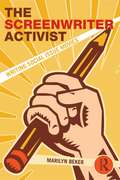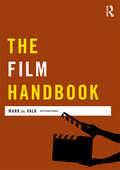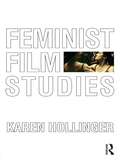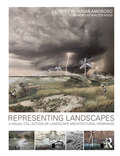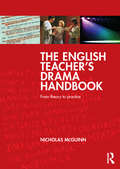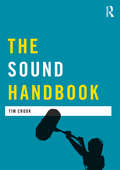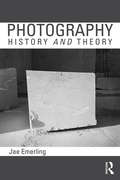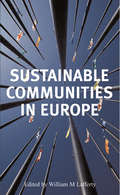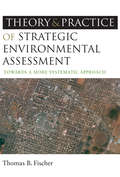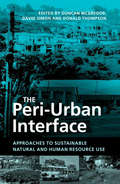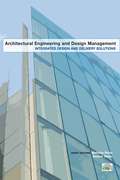- Table View
- List View
Exercises in Architecture: Learning to Think as an Architect
by Simon UnwinArchitecture is a doing word. You can learn a great deal about the workings of architecture through analysing examples but a fuller understanding of its powers and potential comes through practice, by trying to do it... This book offers student architects a series of exercises that will develop their capacity for doing architecture. Exercises in Architecture builds on and supplements the methodology for architectural analysis presented in the author’s previous book Analysing Architecture (third edition, Routledge, 2009) and demonstrated in his Twenty Buildings Every Architect Should Understand (Routledge, 2010). The three books taken together deal with the three aspects of learning: description, analysis of examples, and practice. The book offers twelve exercises, each divided into a short series of tasks aimed at developing a particular theme or area of architectural capacity. The exercises deal with themes such as place-making, learning through drawing, framing, light, , uses of geometry, stage setting, eliciting emotional responses, the genetics of detail and so forth.
The Magazines Handbook
by Jenny McKayThe Magazines Handbook has firmly established itself as the essential introduction to the theories and practices of the modern magazine industry. This fully updated third edition comprehensively examines the business of publishing magazines today and the work of the contemporary magazine journalist. Jenny McKay draws examples from a broad range of publications to explore key jobs in the industry, covering everyone from the sub editor to the fashion assistant, as well as analysing the many skills involved in magazine journalism, including commissioning, researching, interviewing, and production. Updated specialist chapters discuss the growth and development of electronic publishing and online journalism, new directions in magazine design, photography and picture editing, and the most up to date legal frameworks in which magazine journalists must operate. The Magazines Handbook includes: • Interviews with magazine journalists, editors, and publishers • Advice on starting out and freelancing in the magazine industry • An analysis of ‘new journalism’ and reportage • A glossary of key terms and specialist concepts • Information on contacts, courses and professional training.
The Magazines Handbook
by Jenny McKayThe Magazines Handbook has firmly established itself as the essential introduction to the theories and practices of the modern magazine industry. This fully updated third edition comprehensively examines the business of publishing magazines today and the work of the contemporary magazine journalist. Jenny McKay draws examples from a broad range of publications to explore key jobs in the industry, covering everyone from the sub editor to the fashion assistant, as well as analysing the many skills involved in magazine journalism, including commissioning, researching, interviewing, and production. Updated specialist chapters discuss the growth and development of electronic publishing and online journalism, new directions in magazine design, photography and picture editing, and the most up to date legal frameworks in which magazine journalists must operate. The Magazines Handbook includes: • Interviews with magazine journalists, editors, and publishers • Advice on starting out and freelancing in the magazine industry • An analysis of ‘new journalism’ and reportage • A glossary of key terms and specialist concepts • Information on contacts, courses and professional training.
Film Theory: Rational Reconstructions
by Warren BucklandIn Film Theory: Rational Reconstructions, Warren Buckland asks a series of questions about how film theory gets written in the first place: How does it select its objects of study and its methods of inquiry? How does it make discoveries and explain filmic phenomena? And, How does it formulate and solve theoretical problems? He asks these questions of film theory through a rational reconstruction and a classical commentary. Both frameworks clarify and reformulate vague and inexact expressions, redefine obscure concepts, and examine the underlying logic of film theory arguments. This not only subjects film theory to rigorous examination; it also teaches students how to write theory, by enabling them to question and critically interrogate the logic of previous film theory arguments. The book consists of nine chapters that closely examine a series of canonical film books and essays in great detail, by Peter Wollen, Laura Mulvey, Thomas Elsaesser, Stephen Heath, and Slavoj Žižek, among others.
Film Theory: Rational Reconstructions
by Warren BucklandIn Film Theory: Rational Reconstructions, Warren Buckland asks a series of questions about how film theory gets written in the first place: How does it select its objects of study and its methods of inquiry? How does it make discoveries and explain filmic phenomena? And, How does it formulate and solve theoretical problems? He asks these questions of film theory through a rational reconstruction and a classical commentary. Both frameworks clarify and reformulate vague and inexact expressions, redefine obscure concepts, and examine the underlying logic of film theory arguments. This not only subjects film theory to rigorous examination; it also teaches students how to write theory, by enabling them to question and critically interrogate the logic of previous film theory arguments. The book consists of nine chapters that closely examine a series of canonical film books and essays in great detail, by Peter Wollen, Laura Mulvey, Thomas Elsaesser, Stephen Heath, and Slavoj Žižek, among others.
The Screenwriter Activist: Writing Social Issue Movies
by Marilyn BekerHotel Rwanda. Philadelphia. Silkwood. Some of the most important films ever made have tackled real-world social issues, from genocide to homophobia to corporate greed. As storytellers, activist screenwriters recognize that social issues make great stories that can be gut-wrenching, heart-tugging, funny, tragic, and interesting to watch. The Screenwriter Activist helps screenwriters tell those stories in compelling, non-preachy, and inspiring ways. The Screenwriter Activist is an in-depth, practical guide, appropriate for students in intermediate or graduate screenwriting courses in Film and English Programs as well as professionals who want to write a movie that can make a difference in the world. Using examples from classic and recent popular films, The Screenwriter Activist: Explores the motivation and sensibility a screenwriter needs to embark on a social issue project Gives techniques for choosing compelling subjects Provides historical context for social issue movies Explains how characters legitimize social issue themes Puts forward specific models for structuring advocacy screenplays Lays out a roadmap for how screenwriters can get a social issue movie made If you care deeply about social issues and recognize that films can be highly effective platforms for motivativng audiences to civic involvement and social action, this is the one screenwriting book you need to read.
The Screenwriter Activist: Writing Social Issue Movies
by Marilyn BekerHotel Rwanda. Philadelphia. Silkwood. Some of the most important films ever made have tackled real-world social issues, from genocide to homophobia to corporate greed. As storytellers, activist screenwriters recognize that social issues make great stories that can be gut-wrenching, heart-tugging, funny, tragic, and interesting to watch. The Screenwriter Activist helps screenwriters tell those stories in compelling, non-preachy, and inspiring ways. The Screenwriter Activist is an in-depth, practical guide, appropriate for students in intermediate or graduate screenwriting courses in Film and English Programs as well as professionals who want to write a movie that can make a difference in the world. Using examples from classic and recent popular films, The Screenwriter Activist: Explores the motivation and sensibility a screenwriter needs to embark on a social issue project Gives techniques for choosing compelling subjects Provides historical context for social issue movies Explains how characters legitimize social issue themes Puts forward specific models for structuring advocacy screenplays Lays out a roadmap for how screenwriters can get a social issue movie made If you care deeply about social issues and recognize that films can be highly effective platforms for motivativng audiences to civic involvement and social action, this is the one screenwriting book you need to read.
The Film Handbook
by Mark De Valk Sarah ArnoldThe Film Handbook examines the current state of filmmaking and how film language, technique and aesthetics are being utilised for today’s ‘digital film’ productions. It reflects on how critical analysis’ of film underpins practice and story, and how developing an autonomous ‘vision’ will best aid student creativity. The Film Handbook offers practical guidance on a range of traditional and independent ‘guerrilla’ film production methods, from developing script ideas and the logistics of planning the shoot to cinematography, sound and directing practices. Film professionals share advice of their creative and practical experiences shooting both on digital and film forms. The Film Handbook relates theory to the filmmaking process and includes: • documentary, narrative and experimental forms, including deliberations on ‘reading the screen’, genre, mise-en-scène, montage, and sound design • new technologies of film production and independent distribution, digital and multi-film formats utilised for indie filmmakers and professional dramas, sound design and music • the short film form, theories of transgressive and independent ‘guerrilla’ filmmaking, the avant-garde and experimental as a means of creative expression • preparing to work in the film industry, development of specialisms as director, producer, cinematographer, editor, and the presentation of creative work.
The Film Handbook
by Mark De Valk Sarah ArnoldThe Film Handbook examines the current state of filmmaking and how film language, technique and aesthetics are being utilised for today’s ‘digital film’ productions. It reflects on how critical analysis’ of film underpins practice and story, and how developing an autonomous ‘vision’ will best aid student creativity. The Film Handbook offers practical guidance on a range of traditional and independent ‘guerrilla’ film production methods, from developing script ideas and the logistics of planning the shoot to cinematography, sound and directing practices. Film professionals share advice of their creative and practical experiences shooting both on digital and film forms. The Film Handbook relates theory to the filmmaking process and includes: • documentary, narrative and experimental forms, including deliberations on ‘reading the screen’, genre, mise-en-scène, montage, and sound design • new technologies of film production and independent distribution, digital and multi-film formats utilised for indie filmmakers and professional dramas, sound design and music • the short film form, theories of transgressive and independent ‘guerrilla’ filmmaking, the avant-garde and experimental as a means of creative expression • preparing to work in the film industry, development of specialisms as director, producer, cinematographer, editor, and the presentation of creative work.
Feminist Film Studies
by Karen HollingerFeminist Film Studies is a readable, yet comprehensive textbook for introductory classes in feminist film theory and criticism. Karen Hollinger provides an accessible overview of women’s representation and involvement in film, complemented by analyses of key texts that illustrate major topics in the field. Key areas include: a brief history of the development of feminist film theory the theorization of the male gaze and the female spectator women in genre films and literary adaptations the female biopic feminism and avant-garde and documentary film women as auteurs lesbian representation women in Third Cinema. Each chapter includes a "Films in Focus" section, which analyzes key texts related to the chapter’s major topic, including examples from classical Hollywood, world cinema, and the contemporary period. This book provides students in both film and gender/women’s studies with a clear introduction to the field of feminist film theory and criticism.
Feminist Film Studies
by Karen HollingerFeminist Film Studies is a readable, yet comprehensive textbook for introductory classes in feminist film theory and criticism. Karen Hollinger provides an accessible overview of women’s representation and involvement in film, complemented by analyses of key texts that illustrate major topics in the field. Key areas include: a brief history of the development of feminist film theory the theorization of the male gaze and the female spectator women in genre films and literary adaptations the female biopic feminism and avant-garde and documentary film women as auteurs lesbian representation women in Third Cinema. Each chapter includes a "Films in Focus" section, which analyzes key texts related to the chapter’s major topic, including examples from classical Hollywood, world cinema, and the contemporary period. This book provides students in both film and gender/women’s studies with a clear introduction to the field of feminist film theory and criticism.
Tony Leung Chiu-Wai (Film Stars)
by Mark GallagherIn this fascinating study, Mark Gallagher explores the dynamics of media stardom in Hong Kong, mainland China and the East Asian region. This includes the importance of television series for training and promotion; the phenomenon of regional, transmedia stardom across popular entertainment genres; and cultural and political considerations as performers move among different Asian production environments. Attentive to Leung’s positions in both East Asian and global screen cultures, this book illuminates challenges and opportunities for Chinese screen actors in local, regional and global contexts. This unique study is an ideal resource for undergraduate students of Film and Media Studies taking courses in Chinese Cinema, Asian Cinema, or Transnational cinema, as well as anyone with an interest in Tony Leung-Chiu Wai's prolific career.
Representing Landscapes: A Visual Collection of Landscape Architectural Drawings
by Nadia AmorosoWhat do you communicate when you draw an industrial landscape using charcoal; what about a hyper-realistic PhotoShop collage method? What are the right choices to make? Are there right and wrong choices when it comes to presenting a particular environment in a particular way? The choice of medium for visualising an idea is something that faces all students of landscape architecture and urban design, and each medium and style option that you select will influence how your idea is seen and understood. Responding to demand from her students, Nadia Amoroso has compiled successful and eye-catching drawings using various drawing styles and techniques to create this book of drawing techniques for landscape architects to follow and - more importantly - to be inspired by. More than twenty respected institutions have helped to bring together the very best of visual representation of ideas, the most powerful, expressive and successful images. Professors from these institutions provide critical and descriptive commentaries, explaining the impact of using different media to represent the same landscape. This book is recommended for landscape architecture and urban design students from first year to thesis and is specifically useful in visual communications and graphic courses and design studios.
Representing Landscapes: A Visual Collection of Landscape Architectural Drawings
by Nadia AmorosoWhat do you communicate when you draw an industrial landscape using charcoal; what about a hyper-realistic PhotoShop collage method? What are the right choices to make? Are there right and wrong choices when it comes to presenting a particular environment in a particular way? The choice of medium for visualising an idea is something that faces all students of landscape architecture and urban design, and each medium and style option that you select will influence how your idea is seen and understood. Responding to demand from her students, Nadia Amoroso has compiled successful and eye-catching drawings using various drawing styles and techniques to create this book of drawing techniques for landscape architects to follow and - more importantly - to be inspired by. More than twenty respected institutions have helped to bring together the very best of visual representation of ideas, the most powerful, expressive and successful images. Professors from these institutions provide critical and descriptive commentaries, explaining the impact of using different media to represent the same landscape. This book is recommended for landscape architecture and urban design students from first year to thesis and is specifically useful in visual communications and graphic courses and design studios.
The English Teacher's Drama Handbook: From theory to practice
by Nicholas McGuinnThe English Teacher’s Drama Handbook is a rich, thought-provoking introduction to teaching drama within the English classroom. Divided into two sections, the first part of the book explores ?deological influences that have shaped drama's relationship with English over the past 250 years and aims to help you locate your own practice within a theoretical and historical context. ?Starting with Rousseau's seminal text Emile, it considers the theories of key thinkers and practitioners and a range of complex issues including the construction of ‘childhood’, children’s play, the teacher and student relationship, the implications of linking ?drama and English and the impact of national curricula on drama and English teaching. ? The second half of the book offers a collection of comprehensive, practical schemes of work to inspire and support you and your students to realise the power of drama in bringing?English language and literature?vividly?to life.? Suitable for a range of ages and abilities, each activity makes explicit links to the key thinkers and issues explored in the first part of the book and explores a particular aspect of work in English - from grammar and spelling to poetry and play texts.? Together with guidance on how to begin and progress the activities, each sequence includes ideas for exploring issues further in the English classroom. ?Written for English teachers at any stage of their career, The English Teacher’s Drama Handbook offers new ways of looking at drama and English that will ensure meaningful and enjoyable teaching and learning. ?
The English Teacher's Drama Handbook: From theory to practice
by Nicholas McGuinnThe English Teacher’s Drama Handbook is a rich, thought-provoking introduction to teaching drama within the English classroom. Divided into two sections, the first part of the book explores ?deological influences that have shaped drama's relationship with English over the past 250 years and aims to help you locate your own practice within a theoretical and historical context. ?Starting with Rousseau's seminal text Emile, it considers the theories of key thinkers and practitioners and a range of complex issues including the construction of ‘childhood’, children’s play, the teacher and student relationship, the implications of linking ?drama and English and the impact of national curricula on drama and English teaching. ? The second half of the book offers a collection of comprehensive, practical schemes of work to inspire and support you and your students to realise the power of drama in bringing?English language and literature?vividly?to life.? Suitable for a range of ages and abilities, each activity makes explicit links to the key thinkers and issues explored in the first part of the book and explores a particular aspect of work in English - from grammar and spelling to poetry and play texts.? Together with guidance on how to begin and progress the activities, each sequence includes ideas for exploring issues further in the English classroom. ?Written for English teachers at any stage of their career, The English Teacher’s Drama Handbook offers new ways of looking at drama and English that will ensure meaningful and enjoyable teaching and learning. ?
The Sound Handbook
by Tim Crook'Tim Crook has written an important and much-needed book, and its arrival on our shelves has come at a highly appropriate time.' Professor Seán Street, Bournemouth University The Sound Handbook maps theoretical and practical connections between the creation and study of sound across the multi-media spectrum of film, radio, music, sound art, websites, animation and computer games entertainment, and stage theatre. Using an interdisciplinary approach Tim Crook explores the technologies, philosophies and cultural issues involved in making and experiencing sound, investigating soundscape debates and providing both intellectual and creative production information. The book covers the history, theory and practice of sound and includes practical production projects and a glossary of key terms. The Sound Handbook is supported by a companion website, signposted throughout the book, with further practical and theoretical resources dedicated to bridging the creation and study of sound across professional platforms and academic disciplines.
Photography: History and Theory
by Jae EmerlingPhotography: History and Theory introduces students to both the history of photography and critical theory. From its inception in the nineteenth century, photography has instigated a series of theoretical debates. In this new text, Jae Emerling therefore argues that the most insightful way to approach the histories of photography is to address simultaneously the key events of photographic history alongside the theoretical discourse that accompanied them. While the nineteenth century is discussed, the central focus of the text is on modern and contemporary photographic theory. Particular attention is paid to key thinkers, such as Baudelaire, Barthes and Sontag. In addition, the centrality of photography to contemporary art practice is addressed through the theoretical work of Allan Sekula, John Tagg, Rosalind Krauss, and Vilém Flusser. The text also includes readings of many canonical photographers and exhibitions including: Atget, Brassai, August Sander, Walker Evans, The Family of Man, Diane Arbus, Lee Friedlander, Cindy Sherman, Bernd and Hilla Becher, Sebastaio Salgado, Jeff Wall, and others. In addition, Emerling provides close readings of key passages from some major theoretical texts. These glosses come between the chapters and serve as a conceptual line that connects them. Glosses include: Roland Barthes, "The Rhetoric of the Image" (1964) Susan Sontag, Regarding the Pain of Others (2002) Michel Foucault on the archive (1969) Walter Benjamin, "Little History of Photography" (1931) Vilém Flusser, Towards a Philosophy of Photography (1983) A substantial glossary of critical terms and names, as well as an extensive bibliography, make this the ideal book for courses on the history and theory of photography.
Sustainable Communities in Europe
by William M LaffertyA presentation of detailed comparative research into the implementation in 11 European countries of Local Agenda 21 - the action plan for sustainable development at community level. Overviews of implementation in each country are accompanied by analysis of positive and negative changes, as well as a comparative analysis with high academic and policy relevance. Numerous practical examples are included of best cases and crucial barriers.
The Theory and Practice of Strategic Environmental Assessment: Towards a More Systematic Approach
by Thomas B Fischer?Anyone serious about integrating environmental factors into planning and policy making will gain new insights and ideas from Fischer?s book on SEA; and students, teachers and practitioners of the subject will find the book essential.? Leonard Ortolano, Professor at Stanford University, USA ?Fischer?s book demystifies the process and substantive analytical dimensions of SEA. Offering solidly documented empirical evidence of the value of SEA to development, the knowledge captured in this book is a great contribution to the practice.? Linda Ghanime, Environmental Operations and Policy Adviser, United Nations Development Program ?This book is an invaluable reference text for SEA practitioners. I recommend it to everyone!? Xu He, Professor and Director of the Strategic Environmental Assessment Center at Nankai University, China ?Fischer gives a concise and wellstructured account of SEA as it is used today. Readers thus will gain important insights into SEA: why it is important, how it works, and what it can and should achieve.? Professor Thomas Bunge, Federal Environment Agency, Germany Strategic Environmental Assessment (SEA) is a fast-growing and rapidly evolving professional field driven by both advances in theory and practice and by regulatory requirements in Europe, North America, Australasia, South Africa and increasingly across Asia. However, to date, analysis of existing practice and associated reporting has remained far from systematic and there has been a clear need for a comprehensive textbook to facilitate teaching, learning and practice in this burgeoning field. This textbook, the first of its kind, provides for a state-ofthe-art review of SEA theory and practice and promotes a more systematic approach to SEA. It is written for a wide student, professional and academic audience and aims particularly at supporting the development of SEA modules in undergraduate and postgraduate planning, environmental assessment, engineering and law courses. It provides an overview of the fundamental principles and rules of SEA, reports systematically on international SEA practice and theory and pushes the envelope by developing the theory. Supporting material includes boxed examples and case studies from around the world, extra reading suggestions and a glossary of terms. This is the essential book for all students, professionals and academics in SEA and EIA and follow-up worldwide.
The Theory and Practice of Strategic Environmental Assessment: Towards a More Systematic Approach
by Thomas B Fischer?Anyone serious about integrating environmental factors into planning and policy making will gain new insights and ideas from Fischer?s book on SEA; and students, teachers and practitioners of the subject will find the book essential.? Leonard Ortolano, Professor at Stanford University, USA ?Fischer?s book demystifies the process and substantive analytical dimensions of SEA. Offering solidly documented empirical evidence of the value of SEA to development, the knowledge captured in this book is a great contribution to the practice.? Linda Ghanime, Environmental Operations and Policy Adviser, United Nations Development Program ?This book is an invaluable reference text for SEA practitioners. I recommend it to everyone!? Xu He, Professor and Director of the Strategic Environmental Assessment Center at Nankai University, China ?Fischer gives a concise and wellstructured account of SEA as it is used today. Readers thus will gain important insights into SEA: why it is important, how it works, and what it can and should achieve.? Professor Thomas Bunge, Federal Environment Agency, Germany Strategic Environmental Assessment (SEA) is a fast-growing and rapidly evolving professional field driven by both advances in theory and practice and by regulatory requirements in Europe, North America, Australasia, South Africa and increasingly across Asia. However, to date, analysis of existing practice and associated reporting has remained far from systematic and there has been a clear need for a comprehensive textbook to facilitate teaching, learning and practice in this burgeoning field. This textbook, the first of its kind, provides for a state-ofthe-art review of SEA theory and practice and promotes a more systematic approach to SEA. It is written for a wide student, professional and academic audience and aims particularly at supporting the development of SEA modules in undergraduate and postgraduate planning, environmental assessment, engineering and law courses. It provides an overview of the fundamental principles and rules of SEA, reports systematically on international SEA practice and theory and pushes the envelope by developing the theory. Supporting material includes boxed examples and case studies from around the world, extra reading suggestions and a glossary of terms. This is the essential book for all students, professionals and academics in SEA and EIA and follow-up worldwide.
The Peri-Urban Interface: Approaches to Sustainable Natural and Human Resource Use
by Duncan McGregor David SimonPeri-urban interfaces - the zones where urban and rural areas meet - suffer from the greatest problems to humans caused by rapid urbanization, including intense pressures on resources, slum formation, lack of adequate services such as water and sanitation, poor planning and degradation of farmland. These areas, home to hundreds of millions of people, face unique problems and need distinctive and innovative approaches and solutions. This book, authored by top researchers and practitioners, covers the full breadth and depth of the impacts of rapid urbanization on livelihoods, poverty and resources in the peri-urban zones in diverse African, Asian, Latin American and Caribbean contexts. Topics include peri-urban resource sustainability, ecosystems and societies and environmental changes in peri-urban zones. Rich case studies cover production systems and livelihoods including the impacts of irrigated vegetable production, horticulture, dairy enterprises, waste-fed fisheries and pastoral livelihoods. Also addressed are planning and development issues in the peri-urban interface including the difficulty in achieving sustainability, conflict and cooperation over resources, and a fresh look at the relationship between people and their environment. The final part of the book presents policies and strategies for promoting and measuring sustainability in peri-urban zones including community-based waste management, the co-management of watersheds and empowerment of the poor. This book is the most comprehensive examination of the challenges and solutions facing the people and environments of peri-urban zones and is essential reading for all practitioners, students and academics in geography and development.
The Peri-Urban Interface: Approaches to Sustainable Natural and Human Resource Use
by Duncan McGregor David SimonPeri-urban interfaces - the zones where urban and rural areas meet - suffer from the greatest problems to humans caused by rapid urbanization, including intense pressures on resources, slum formation, lack of adequate services such as water and sanitation, poor planning and degradation of farmland. These areas, home to hundreds of millions of people, face unique problems and need distinctive and innovative approaches and solutions. This book, authored by top researchers and practitioners, covers the full breadth and depth of the impacts of rapid urbanization on livelihoods, poverty and resources in the peri-urban zones in diverse African, Asian, Latin American and Caribbean contexts. Topics include peri-urban resource sustainability, ecosystems and societies and environmental changes in peri-urban zones. Rich case studies cover production systems and livelihoods including the impacts of irrigated vegetable production, horticulture, dairy enterprises, waste-fed fisheries and pastoral livelihoods. Also addressed are planning and development issues in the peri-urban interface including the difficulty in achieving sustainability, conflict and cooperation over resources, and a fresh look at the relationship between people and their environment. The final part of the book presents policies and strategies for promoting and measuring sustainability in peri-urban zones including community-based waste management, the co-management of watersheds and empowerment of the poor. This book is the most comprehensive examination of the challenges and solutions facing the people and environments of peri-urban zones and is essential reading for all practitioners, students and academics in geography and development.
Integrated Design and Delivery Solutions
by Matthijs Prins Robert OwenIntegrated Design and Delivery Solutions (IDDS) represent a significant new research trajectory in the integration of architecture and construction through the rapid adoption of new processes. This book examines the ways in which collaboration and new methods of contracting and procurement enhance skills and improve processes in terms of lean and sustainable construction. Based on high quality research and practice-based examples that provide key insights into IDDS and its future potential, this book surveys the technologies that are being employed to create more sustainable buildings with added value for clients, stakeholders and society as whole.
Integrated Design and Delivery Solutions
by Matthijs Prins Robert OwenIntegrated Design and Delivery Solutions (IDDS) represent a significant new research trajectory in the integration of architecture and construction through the rapid adoption of new processes. This book examines the ways in which collaboration and new methods of contracting and procurement enhance skills and improve processes in terms of lean and sustainable construction. Based on high quality research and practice-based examples that provide key insights into IDDS and its future potential, this book surveys the technologies that are being employed to create more sustainable buildings with added value for clients, stakeholders and society as whole.

